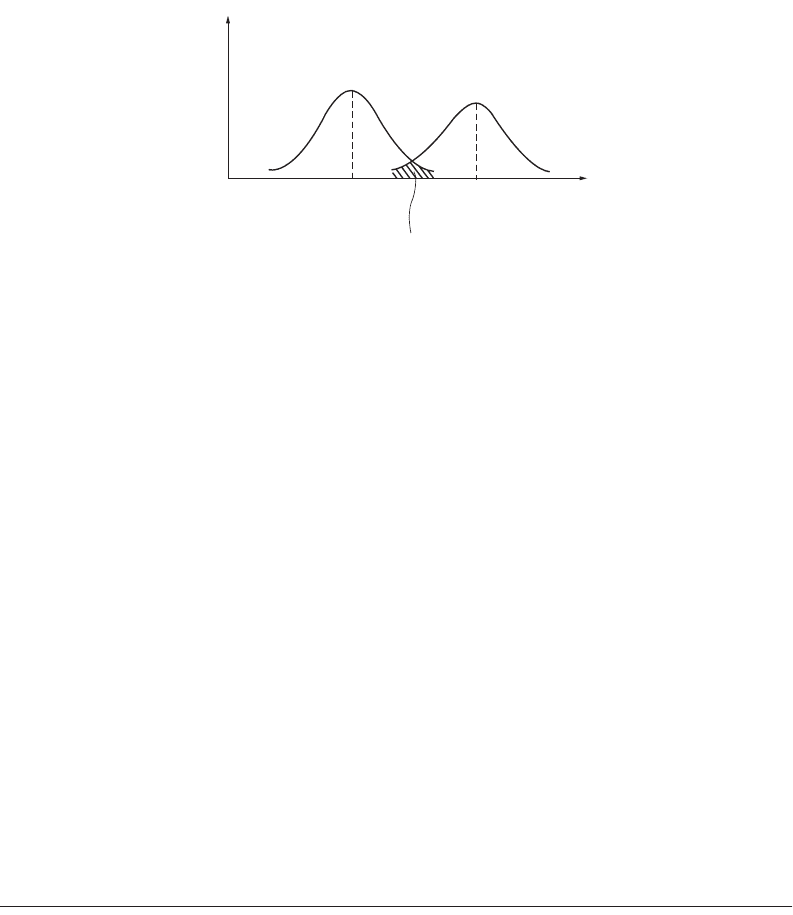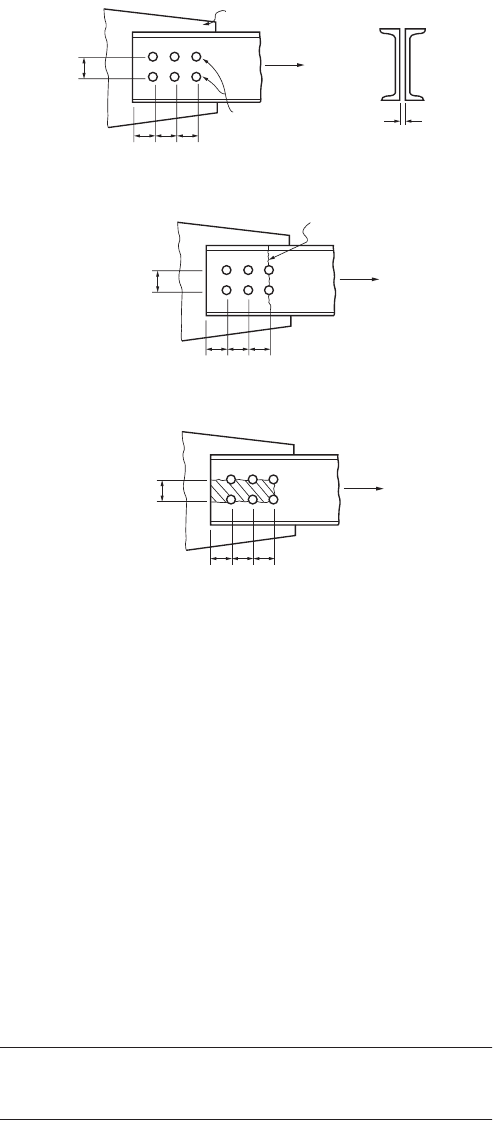Wai-Fah Chen.The Civil Engineering Handbook
Подождите немного. Документ загружается.


48
-4
The Civil Engineering Handbook, Second Edition
Corrosion Protection of Steel
Atmospheric corrosion occurs when steel is exposed to a continuous supply of water and oxygen. The
rate of corrosion can be reduced if a barrier is used to keep water and oxygen from contact with the
surface of bare steel. Painting is a practical and cost-effective way to protect steel from corrosion. The
Steel Structures Painting Council issues specifications for the surface preparation and painting of steel
structures for corrosion protection of steel. In lieu of painting, the use of other coating materials such
as epoxies or other mineral and polymeric compounds can be considered. The use of corrosion resistance
steels such as ASTM A242, A588, or A606 steel or galvanized or stainless steel is another alternative.
Corrosion-resistant steels such as A588 retard corrosion by the formation of a layer of deep reddish
brown to black patina (an oxidized metallic film) on the steel surface after a few wetting–drying cycles,
which usually take place within 1 to 3 years. Galvanized steel has a zinc coating. In addition to acting as
a protective cover, zinc is anodic to steel. The steel, being cathodic, is therefore protected from corrosion.
Stainless steel is more resistant to rusting and staining than ordinary steel, primarily because of the
presence of chromium as an alloying element.
TA BLE 48.1
Steel Types and General Uses
ASTM Designation
F
y
(ksi)
a
F
u
(ksi)
a
Plate
Thickness
(in.)
b
General Uses
A36/A36M 36 58–80 To 8 Riveted, bolted, and welded buildings and
bridges
A529/A529M 42
50
60–85
70–100
To 0.5
To 1.5
Similar to A36; the higher yield stress for
A529 steel allows for savings in weight;
A529 supersedes A441
A572/A572M
Grade 42
Grade 50
Grade 60
Grade 65
42
50
60
65
60
65
75
80
To 6
To 4
To 1.25
To 1.25
Grades 60 and 65 not suitable for welded
bridges
A242/A242M 42
46
50
63
67
70
1.5–5
0.75–1.5
0.5–0.75
Riveted, bolted, and welded buildings and
bridges; used when weight savings and
enhanced atmospheric corrosion
resistance are desired; specific instructions
must be provided for welding
A588/A588M 42
46
50
63
67
70
5–8
4–5
To 4
Similar to A242; atmospheric corrosion
resistance is about four times that of A36
steel
A709/A709M
Grade 36
Grade 50
Grade 50W
Grade 70W
Grades 100 and 100W
Grades 100 and 100W
36
50
50
70
90
100
58–80
65
70
90–110
100–130
110–130
To 4
To 4
To 4
To 4
2.5–4
To 2.5
Primarily for use in bridges
A852/A852M 70 90–110 To 4 Plates for welded and bolted construction
where atmospheric corrosion resistance is
desired
A514/A514M 90–100 100–130
110–130
2.5–6 Primarily for welded bridges; avoid use if
ductility is important
A913/A913M 50–65 65 (max.
F
y
/
F
u
= 0.85) To 4 Used for seismic applications
A992/A992M 50–65 65(max.
F
y
/
F
u
= 0.85) To 4 Hot-rolled wide flange shapes for use in
building frames
a
1 ksi = 6.895 MPa.
b
1in. = 25.4 mm.
© 2003 by CRC Press LLC
Design of Steel Structures
48
-5
Structural Steel Shapes
Steel sections used for construction are available in a variety of shapes and sizes. In general, there are
three procedures by which steel shapes can be formed: hot rolled, cold formed, and welded. All steel
shapes must be manufactured to meet ASTM standards. Commonly used steel shapes include the wide
flange (W) sections, the American Standard beam (S) sections, bearing pile (HP) sections, American
Standard channel (C) sections, angle (L) sections, and tee (WT) sections, as well as bars, plates, pipes,
and hollow structural sections (HSS). I sections that, by dimensions, can not be classified as W or S
shapes are designated miscellaneous (M) sections, and C sections that, by dimensions, can not be classified
as American Standard channels are designated miscellaneous channel (MC) sections.
Hot-rolled shapes are classified in accordance with their tensile property into five size groups by the
American Society of Steel Construction (AISC). The groupings are given in the AISC manuals [AISC,
1989, 2001]. Groups 4 and 5 shapes and group 3 shapes with a flange thickness exceeding 1
½
in. are
generally used for application as
compression members
. When weldings are used, care must be exercised
to minimize the possibility of cracking in regions at the vicinity of the welds by carefully reviewing the
material specification and fabrication procedures of the pieces to be joined.
Structural Fasteners
Steel sections can be fastened together by rivets, bolts, and welds. Although rivets were used quite
extensively in the past, their use in modern steel construction has become almost obsolete. Bolts have
essentially replaced rivets as the primary means to connect nonwelded structural components.
Bolts
Four basic types of bolts are commonly in use. They are designated by ASTM as A307, A325, A490, and
A449 [ASTM, 2001a, 2001b, 2001c, 2001d]. A307 bolts are called common, unfinished, machine, or
rough bolts. They are made from low-carbon steel. Two grades (A and B) are available. They are available
in diameters from 1/4 to 4 in. (6.4 to 102 mm) in 1/8-in. (3.2-mm) increments. They are used primarily
for low-stress connections and for secondary members. A325 and A490 bolts are called high-strength
bolts. A325 bolts are made from a heat-treated medium-carbon steel. They are available in two types:
type 1, bolts made of medium-carbon steel; and type 3, bolts having atmospheric corrosion resistance
and weathering characteristics comparable to those of A242 and A588 steel. A490 bolts are made from
quenched and tempered alloy steel and thus have a higher strength than A325 bolts. Like A325 bolts,
two types (types 1 and 3) are available. Both A325 and A490 bolts are available in diameters from 1/2 to
1
½
in. (13 to 38 mm) in 1/8-in. (3.2-mm) increments. They are used for general construction purposes.
A449 bolts are made from quenched and tempered steel. They are available in diameters from 1/4 to
3 in. (6.4 to 76 mm). Because A449 bolts are not produced to the same quality requirements or same
heavy hex head and nut dimensions as A325 or A490 bolts, they are not to be used for slip critical
connections. A449 bolts are used primarily when diameters over 1
½
in. (38 mm) are needed. They are
also used for anchor bolts and threaded rods.
High-strength bolts can be tightened to two conditions of tightness: snug tight and fully tight. Snug-
tight conditions can be attained by a few impacts of an impact wrench or the full effort of a worker using
an ordinary spud wrench. Snug-tight conditions must be clearly identified on the design drawing and
are permitted in bearing-type connections where a slip is permitted or in tension or combined shear and
tension applications where loosening or fatigue due to vibration or load fluctuations is not a design
consideration. Bolts used in slip-critical conditions (i.e., conditions for which the integrity of the con-
nected parts is dependent on the frictional force developed between the interfaces of the joint) and in
conditions where the bolts are subjected to direct tension are required to be tightened to develop a
pretension force equal to about 70% of the minimum tensile stress
F
u
of the material from which the
bolts are made. This can be accomplished by using the turn-of-the-nut method, the calibrated wrench
method, alternate design fasteners, or direct tension indicators [RCSC, 2000].
© 2003 by CRC Press LLC

48
-6
The Civil Engineering Handbook, Second Edition
Welds
Welding is a very effective means to connect two or more pieces of material together. The four most
commonly used welding processes are
shielded metal arc welding
(SMAW),
submerged arc welding
(SAW),
gas metal arc welding
(GMAW), and
flux core arc welding
(FCAW) [AWS, 2000]. Welding can be done
with or without filler materials, although most weldings used for construction utilize filler materials. The
filler materials used in modern-day welding processes are electrodes. Table 48.2 summarizes the electrode
designations used for the aforementioned four most commonly used welding processes. In general, the
strength of the electrode used should equal or exceed the strength of the steel being welded [AWS, 2000].
Finished welds should be inspected to ensure their quality. Inspection should be performed by qualified
welding inspectors. A number of inspection methods are available for weld inspections. They include
visual methods; the use of liquid penetrants, magnetic particles, and ultrasonic equipment; and radio-
graphic methods. Discussion of these and other welding inspection techniques can be found in the
Welding Handbook
[AWS, 1987].
Weldability of Steel
Weldability is the capacity of a material to be welded under a specific set of fabrication and design
conditions and to perform as expected during its service life. Generally speaking, weldability is considered
very good for low-carbon steel (carbon level, <0.15% by weight), good for mild steel (carbon level, 0.15 to
0.30%), fair for medium-carbon steel (carbon level, 0.30 to 0.50%), and questionable for high-carbon
steel (carbon level, 0.50 to 1.00%). Because weldability normally decreases with increasing carbon content,
special precautions such as preheating, controlling heat input, and postweld heat treating are normally
required for steel with a carbon content reaching 0.30%. In addition to carbon content, the presence of
other alloying elements will have an effect on weldability. In lieu of more accurate data, the table below
can be used as a guide to determine the weldability of steel [Blodgett, undated].
TABLE 48.2
Electrode Designations
We lding
Processes
Electrode
Designations Remarks
Shielded metal
arc welding
(SMAW)
E60XX
E70XX
E80XX
E100XX
E110XX
The E denotes electrode; the first two digits indicate tensile strength in ksi
a
; the two
X’s represent numbers indicating the electrode use
Submerged arc
welding
(SAW)
F6X-EXXX
F7X-EXXX
F8X-EXXX
F10X-EXXX
F11X-EXXX
The F designates a granular flux material; the digit(s) following the F indicate the
tensile strength in ksi (6 means 60 ksi, 10 means 100 ksi, etc.); the digit before the
hyphen gives the Charpy V-notched impact strength; the E and the X’s that follow
represent numbers relating to the electrode use
Gas metal arc
welding
(GMAW)
ER70S-X
ER80S
ER100S
ER110S
The digits following the letters ER represent the tensile strength of the electrode in ksi
Flux cored arc
welding
(FCAW)
E6XT-X
E7XT-X
E8XT
E10XT
E11XT
The digit(s) following the letter E represent the tensile strength of the electrode in
ksi (6 means 60 ksi, 10 means 100 ksi, etc.)
a
1 ksi = 6.895 MPa.
© 2003 by CRC Press LLC

Design of Steel Structures
48
-7
A quantitative approach to determine the weldability of steel is to calculate its
carbon equivalent value
.
One definition of the carbon equivalent value C
eq
is
(48.1)
A steel is considered weldable if C
eq
£ 0.50% for steel in which the carbon content does not exceed
0.12%, and if C
eq
£ 0.45% for steel in which the carbon content exceeds 0.12%.
The above equation indicates that the presence of alloying elements decreases the weldability of steel.
An example of high-alloy steels is stainless steel. There are three types of stainless steel: austenitic,
martensitic, and ferritic. Austenitic stainless steel is the most weldable, but care must be exercised to
prevent thermal distortion, because heat dissipation is only about one third as fast as it is in plain carbon
steel. Martensitic steel is also weldable, but prone to cracking because of its high ability to harden.
Preheating and the maintaining of an interpass temperature are often needed, especially when the carbon
content is above 0.10%. Ferritic steel is weldable, but decreased ductility and toughness in the weld area
can present a problem. Preheating and postweld annealing may be required to minimize these undesirable
effects.
48.2 Design Philosophy and Design Formats
Design Philosophy
Structural design should be performed to satisfy the criteria for strength, serviceability, and economy.
Strength pertains to the general integrity and safety of the structure under extreme load conditions. The
structure is expected to withstand occasional overloads without severe distress and damage during its
lifetime. Serviceability refers to the proper functioning of the structure as related to its appearance,
maintainability, and durability under normal, or service load, conditions. Deflection, vibration, perma-
nent deformation, cracking, and corrosion are some design considerations associated with serviceability.
Economy is concerned with the overall material, construction, and labor costs required for the design,
fabrication, erection, and maintenance processes of the structure.
Design Formats
At present, steel design in the U.S. can be performed in accordance with one of the following three formats:
Allowable stress design (ASD), which has been in use for decades for the steel design of buildings and
bridges. It continues to enjoy popularity among structural engineers engaged in steel building
design. In allowable stress (or working stress) design, member stresses computed under service
(or working) loads are compared to some predesignated stresses called allowable stresses. The
allowable stresses are often expressed as a function of the yield stress (F
y
) or tensile stress (F
u
) of
Element
Range for Satisfactory
We ldability (%)
Level Requiring
Special Care (%)
Carbon
Manganese
Silicon
Sulfur
Phosphorus
0.06–0.25
0.35–0.80
0.10 max.
0.035 max.
0.030 max.
0.35
1.40
0.30
0.050
0.040
C
eq
=
()()
()
Carbon +
Manganese + Silicon
6
+
Copper + Nickel
15
+
Chromium + Molybdenum + Vanadium +Columbium
5
© 2003 by CRC Press LLC

48-8 The Civil Engineering Handbook, Second Edition
the material divided by a factor of safety. The factor of safety is introduced to account for the
effects of overload, understrength, and approximations used in structural analysis. The general
format for an allowable stress design has the form
(48.2)
where R
n
= the nominal resistance of the structural component expressed in unit of stress (i.e.,
the allowable stress)
Q
ni
= the service, or working, stresses computed from the applied working load of type i
F.S. = the factor of safety, i is the load type (dead, live, wind, etc.)
m = the number of load type considered in the design
Plastic design (PD), which makes use of the fact that steel sections have reserved strength beyond the
first yield condition. When a section is under flexure, yielding of the cross section occurs in a
progressive manner, commencing with the fibers farthest away from the neutral axis and ending
with the fibers nearest the neutral axis. This phenomenon of progressive yielding, referred to as
plastification, means that the cross section does not fail at first yield. The additional moment that
a cross section can carry in excess of the moment that corresponds to first yield varies, depending
on the shape of the cross section. To quantify such reserved capacity, a quantity called the shape
factor, defined as the ratio of the plastic moment (moment that causes the entire cross section to
yield, resulting in the formation of a plastic hinge) to the yield moment (moment that causes
yielding of the extreme fibers only) is used. The shape factor for hot-rolled I-shaped sections bent
about the strong axes has a value of about 1.15. The value is about 1.50 when these sections are
bent about their weak axes.
For an indeterminate structure, failure of the structure will not occur after the formation of a
plastic hinge. After complete yielding of a cross section, force (or, more precisely, moment)
redistribution will occur in which the unyielded portion of the structure continues to carry any
additional loadings. Failure will occur only when enough cross sections have yielded, rendering
the structure unstable, resulting in the formation of a plastic collapse mechanism.
In plastic design, the factor of safety is applied to the applied loads to obtain factored loads. A
design is said to have satisfied the strength criterion if the load effects (i.e., forces, shears, and
moments) computed using these factored loads do not exceed the nominal plastic strength of the
structural component. Plastic design has the form
(48.3)
where R
n
= the nominal plastic strength of the member
Q
ni
= the nominal load effect from loads of type i
g = the load factor
i = the load type
m = the number of load types.
In steel building design, the load factor is given by the AISC specification as 1.7 if Q
n
consists
of dead and live gravity loads only, and as 1.3 if Q
n
consists of dead and live gravity loads acting
in conjunction with wind or earthquake loads.
Load and resistance factor design (LRFD) which is a probability-based limit state design procedure. A
limit state is defined as a condition in which a structure or structural component becomes unsafe
(i.e., a violation of the strength limit state) or unsuitable for its intended function (i.e., a violation
of the serviceability limit state). In a limit state design, the structure or structural component is
R
F.S.
Q
n
i=1
m
ni
≥
Â
R Q
n
i=1
m
ni
≥
Â
g
© 2003 by CRC Press LLC

Design of Steel Structures 48-9
designed in accordance to its limits of usefulness, which may be strength related or serviceability
related. In developing the LRFD method, both load effects and resistance were treated as random
variables. Their variabilities and uncertainties were represented by frequency distribution curves.
A design is considered satisfactory according to the strength criterion if the resistance exceeds the
load effects by a comfortable margin. The concept of safety is represented schematically in Fig. 48.2.
Theoretically, the structure will not fail unless the load effect Q exceeds the resistance R, as shown
by the shaded portion in the figure. The smaller this shaded area, the less likely that the structure
will fail. In actual design, a resistance factor f is applied to the nominal resistance of the structural
component to account for any uncertainties associated with the determination of its strength, and
a load factor g is applied to each load type to account for the uncertainties and difficulties associated
with determining its actual load magnitude. Different load factors are used for different load types
to reflect the varying degree of uncertainties associated with the determination of load magnitudes.
In general, a lower load factor is used for a load that is more predicable, and a higher load factor
is used for a load that is less predicable. Mathematically, the LRFD format takes the form
(48.4)
where fR
n
represents the design (or usable) strength and S
i
Q
ni
represents the required strength or
load effect for a given load combination. Table 48.3 shows examples of load combinations [ASCE,
1998] to be used on the right-hand side of Eq. (48.4). For a safe design, all load combinations
should be investigated and the design based on the worst-case scenario.
48.3 Tension Members
Tension members are designed to resist tensile forces. Examples of tension members are hangers, truss
members, and bracing members that are in tension. Cross sections that are used most often for tension
members are solid and hollow circular rods, bundled bars and cables, rectangular plates, single and
double angles, channels, WT and W sections, and a variety of built-up shapes.
Tension Member Design
Tension members are to be designed to preclude the following possible failure modes under normal load
conditions: yielding in gross section, fracture in effective net section, block shear, shear rupture along a
plane through the fasteners, bearing on fastener holes, and prying (for lap or hanger-type joints). In
addition, the fasteners’ strength must be adequate to prevent failure in the fasteners. Also, except for rods
in tension, the slenderness of the tension member obtained by dividing the length of the member by its
least radius of gyration should preferably not exceed 300.
FIGURE 48.2 Frequency distribution of load effect and resistance.
Frequency
Load Effect
Load Effect
Resistance
R<Q
(Unsafe)
Resistance
Q
m
Q
R
R
m
fg RQ
n
i=1
m
ini
≥
Â
© 2003 by CRC Press LLC

48-10 The Civil Engineering Handbook, Second Edition
Allowable Stress Design
The computed tensile stress f
t
in a tension member shall not exceed the allowable stress for tension F
t
,
given by 0.60F
y
for yielding on the gross area and by 0.50F
u
for fracture on the effective net area. While
the gross area is just the nominal cross-sectional area of the member, the effective net area is the smallest
cross-sectional area accounting for the presence of fastener holes and the effect of shear lag. It is calculated
using the equation
(48.5)
where U is a reduction coefficient given by [Munse and Chesson, 1963].
(48.6)
in which l is the length of the connection and
–
x is the larger of the distance measured from the centroid
of the cross section to the contact plane of the connected pieces or to the fastener lines. In the event that
the cross section has two symmetrically located planes of connection,
–
x is measured from the centroid
of the nearest one half the area (Fig. 48.3). This reduction coefficient is introduced to account for the
shear lag effect that arises when some component elements of the cross section in a joint are not connected,
rendering the connection less effective in transmitting the applied load. The terms in brackets in Eq. (48.5)
constitute the so-called net section A
n
. The various terms are defined as follows:
A
g
=gross cross-sectional area
d
n
=nominal diameter of the hole (bolt cutout), taken as the nominal bolt diameter plus 1/8 in.
(3.2 mm)
t = thickness of the component element
s =longitudinal center-to-center spacing (pitch) of any two consecutive fasteners in a chain of
staggered holes
g =transverse center-to-center spacing (gauge) between two adjacent fastener gauge lines in a
chain of staggered holes
TA BLE 48.3 Load Factors and Load Combinations
1.4D
1.2(D + F + T) + 1.6(L + H) + 0.5(L
r
or S or R)
1.2D + 1.6(L
r
or S or R) + (0.5L or 0.8W)
1.2D + 1.3W + 0.5L + 0.5(L
r
or S or R)
1.2D + 1.0E + 0.5L + 0.2S
0.9D + (1.3W or 1.0E)
where D =dead load
E = earthquake load
F =load due to fluids with well-defined pressures and maximum heights
H =load due to the weight and lateral pressure of soil and water in soil
L =live load
L
r
=roof live load
R =rain load
S = snow load
T =self-straining force
W =wind load
Note: The load factor on L in the third, fourth, and fifth load combinations
shown above shall equal 1.0 for garages, areas occupied as places of public assembly,
and all areas where the live load is greater than 100 psf (4.79 kN/m
2
).
AUAUA dt
s
g
t
en g
i=1
m
ni i
j=1
k
j
j
== - +
Ê
Ë
Á
ˆ
¯
˜
È
Î
Í
Í
˘
˚
˙
˙
ÂÂ
2
4
U
x
l
=- £1090.
© 2003 by CRC Press LLC

Design of Steel Structures 48-11
The second term inside the brackets of Eq. (48.5) accounts for loss of material due to bolt cutouts;
the summation is carried for all bolt cutouts lying on the failure line. The last term inside the brackets
of Eq. (48.5) indirectly accounts for the effect of the existence of a combined stress state (tensile and
shear) along an inclined failure path associated with staggered holes. The summation is carried for all
staggered paths along the failure line. This term vanishes if the holes are not staggered. Normally, it is
necessary to investigate different failure paths that may occur in a connection; the critical failure path is
the one giving the smallest value for A
e
.
To prevent block shear failure and shear rupture, the allowable strengths for block shear and shear
rupture are specified as follows:
Block shear:
(48.7)
Shear rupture:
(48.8)
where A
v
= the net area in shear
A
t
= the net area in tension
F
u
= the specificed mininum tensile strength.
The tension member should also be designed to possess adequate thickness, and the fasteners should
be placed within a specific range of spacings and edge distances to prevent failure due to bearing or
prying action (see Section 48.11).
FIGURE 48.3 Definition of
–
x for selected cross-sections.
x
x
x x
x
x
x
x
x
x x
x
x
x
x
x
x
x
x
x
x
x
Fastener Axis
Centroid Contact Plane
R AF AF
BS v u t u
=+030 050..
FF
vu
= 030.
© 2003 by CRC Press LLC

48-12 The Civil Engineering Handbook, Second Edition
Load and Resistance Factor Design
According to the LRFD specification [AISC, 1999], tension members designed to resist a factored axial
force of P
u
calculated using the load combinations shown in Table 48.3 must satisfy the condition of
(48.9)
The design strength f
t
P
n
is evaluated as follows:
Yielding in gross section:
(48.10)
where 0.90 = the resistance factor for tension
F
y
= the specified minimum yield stress of the material
A
g
= the gross cross-sectional area of the member.
Fracture in effective net section:
(48.11)
where 0.75 = the resistance factor for fracture in tension
F
u
= the specified minimum tensile strength
A
e
= the effective net area given in Eq. (48.5).
Block shear: if F
u
A
nt
≥ 0.6F
u
A
nv
(i.e., shear yield–tension fracture),
(48.12a)
and if F
u
A
nt
< 0.6F
u
A
nv
(i.e., shear fracture–tension yield),
(48.12b)
where 0.75 = the resistance factor for block shear
F
y
and F
u
= the specified minimum yield stress and tensile strength, respectively
A
gv
= the gross shear area
A
nt
= the net tension area
A
nv
= the net shear area
A
gt
= the gross tension area.
Example 48.1
Using LRFD, select a double-channel tension member, shown in Fig. 48.4a, to carry a dead load D of
40 kips and a live load L of 100 kips. The member is 15 feet long. Six 1-in.-diameter A325 bolts in
standard-size holes are used to connect the member to a 3/8-in. gusset plate. Use A36 steel (F
y
= 36 ksi,
F
u
= 58 ksi) for all the connected parts.
Load combinations:
From Table 48.3, the applicable load combinations are:
The design of the tension member is to be based on the larger of the two, i.e., 208 kips, and so each
channel is expected to carry 104 kips.
f
tn u
PP≥
tn y g
PF A
f
=
[]
090.
tn u e
P F A
f
=
[]
075.
tn y gv unt unv unt
P F AFAFAFA
f
=+
[]
£+
[]
075060 07506.. ..
tn u nv y gt unv unt
P F A F A F A F A
f
=+
[]
£+
[]
075060 075060.. ..
14 14 40 56.. kips
1.2 1.6 1.2 40 1.6 100 208 kips
D
DL
=
()
=
+=
()
+
()
=
© 2003 by CRC Press LLC

Design of Steel Structures 48-13
Yielding in gross section:
Using Eqs. (48.9) and (48.10), the gross area required to prevent cross section yielding is
From the section properties table contained in the AISC-LRFD manual, one can select the following trial
sections: C8x11.5 (A
g
= 3.38 in.
2
), C9x13.4 (A
g
= 3.94 in.
2
), or C8x13.75 (A
g
= 4.04 in.
2
).
Check for the limit state of fracture on the effective net area:
The above sections are checked for the limiting state of fracture in the following table:
From the last column of the above table, it can be seen that fracture is not a problem for any of the trial section.
FIGURE 48.4 Design of a double-channel tension member (1 in. = 25.4 mm).
Section A
g
(in.
2
)
t
gw
(in.)
–
x
(in.) U
a
A
e
b
(in.
2
)
ff
ff
t
P
n
(kips)
C8x11.5 3.38 0.220 0.571 0.90 2.6 113.1
C9x13.4 3.94 0.233 0.601 0.90 3.07 133.5
C8x13.75 4.04 0.303 0.553 0.90 3.02 131.4
a
Eq. (48.6).
b
Eq. (48.5), Fig. 48.4b.
3"
3" 3"
3"
3"
3"
3" 3" 3"
3" 3"
(b) Fracture Failure
(c) Block Shear Failure
3"
3
/
8"
P
u
P
u
P
u
3/8" Thick
Gusset Plate
1" Diameter
A325 bolts
Most Probable
Fracture Path
(a) A Double Channel Tension Member
090
090 36 104
321
.
.
.
F A P
A
A
yg u
g
g
r eqd
[]
≥
()
()
[]
≥
()
≥
¢
kips
in
2
© 2003 by CRC Press LLC
